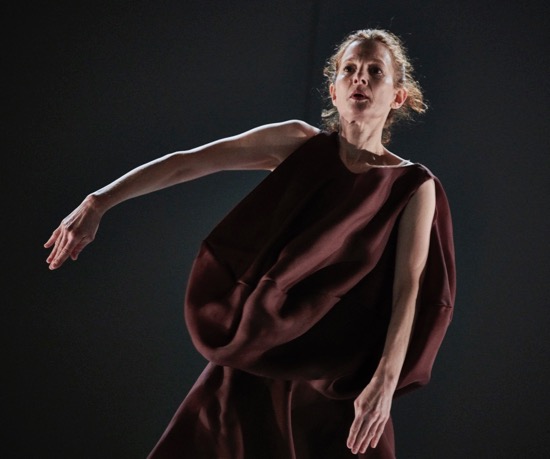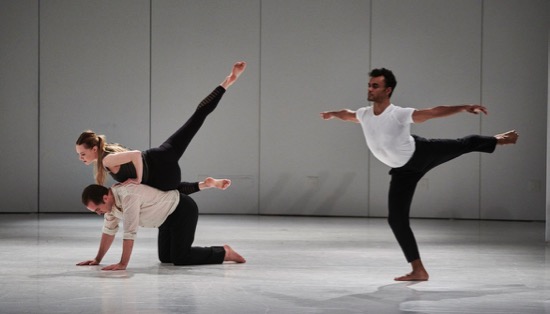The Guggenheim Museum’s Works & Process series presents two works by Jodi Melnick on January 14th and 15th.

Jodi Melnick in One of Sixty-Five Thousand Gestures, choreographed by Trisha Brown and Melnick. Photo: Robert Altman
I didn’t try to count the gestures in One of Sixty-Five Thousand Gestures, a 2012 collaboration between Trisha Brown and Jodi Melnick. Nor did I think about the “one” of the title while Melnick was dancing alone on the small stage of the Guggenheim Museum’s Peter B. Sharp Theater during one of the museum’s Works and Processes events. This is not dancing as an exhibition or dancing that mimes a story; it’s dancing as a way of life. To music by Hahn Rowe that’s watchful, delicately assertive, Melnick muses and considers space and her body’s possibilities. She’s almost always on the move, and the full plum-colored tunic that she wears billows slightly in her wake. The garment by Yeohlee Teng evokes (but doesn’t reference) Isadora Duncan’s long-ago “Greek” attire.
What Melnick devised with Brown, who died last March (how I miss her!), has the air of a dreamy, veering soliloquy. She may dance loosely, lope a little, flutter, then restrain herself and concentrate on a small, exact move or two. Sometimes her gaze will shift in one direction, while her shoulder pulls her elsewhere, and her feet delay a decision. Yet these currents are all part of the same looping stream. Rowe’s score, like her choreography, moves between density and sparseness. The space becomes alive for her. You don’t need to know what she’s thinking; you can see that she is thinking.
The piece, dedicated to Brown and her husband, Burt Barr (also deceased), acts as a prelude to Melnick’s NEW BODIES (2016), commissioned by Works & Process. The title might more aptly refer to new mindsets as well. The adventurous performers, who have been working on this project with Melnick for some time, are Jared Angle, Sara Mearns, and Taylor Stanley— all principal dancers in the New York City Ballet (Stanley replaced injured corps de ballet member Gretchen Smith partway through the process). So here are these fantastically skilled classical dancers being more. . .well, natural, more themselves, but also doing choreography that demands a different kind of thinking. For sure, it has nothing to do with looking elegant and poised at every minute.

L to R: Sara Mearns, Taylor Stanley (seated), and Jared Angle in Jodi Melnick’s NEW BODIES. Photo: Robert Altman
The performers—finely lit by Joe Levasseur and costumed by Marc Happel—are very close to us in this handsome, intimate, semicircular theater; no orchestra pit separates us from them. Robert Boston, who composed one of the pieces accompanying the dance, sits at a harpsichord very close to one bank of spectators, and when NEW BODIES begins, Stanley is crouching on the opposite side of the curving stage, within touching distance of the front row. The first thing he does is turn his back on us and look at Ellsworth Kelly’s large, dark gray, three-sided art work, Wright Curve, on the wall beside him. Really look at it, before he rises and walks onto the stage proper. As he reaches stage left, he pushes one of the wall panels, and, surprisingly, it fans out; it’s still moving as he continues out of sight. A lovely way of suggesting that we take nothing for granted.
How often do we see Mearns sit at the front of a stage, look at us, gaze into where an orchestra pit might be, and lie back for a short rest? Never. Until now. The steps that she performs so beautifully at the former New York State Theater usually draw our eyes to a clear image; Melnick asks for a more complex one, a rediscovery of everydayness. When the two men enter and begin to make gestures with their arms, it’s as if they’re having a conversation. Vibrating sounds set the three in action, and, of course, they dance wonderfully, but they make their unison leaps look almost tossed off, their high-swinging legs just part of a day’s work.

Jared Angle catches Sara Mearns in Jodi Melnick’s NEW BODIES, part of the Guggenheim Museum’s Works & Process series. Taylor Stanley at back.
Photo: Robert Altman
Melnick organized her choreography imaginatively. The three slip fluently from unison into diversity and back again, playing games with our eyes. Each dancer has a moment alone. They work in silence or to music (Boston’s sympathetic commissioned piece, György Ligeti’s jangling, vibrating Continuum for Harpsichord, and Heinrich Biber’s passionate 17th-century Passacaglia, which violinist Monica Davis plays on one of the stage’s side extensions). You notice moves that might be unusual in the ballet world: one person, say, slumping backward and being caught under the armpits by another and hoisted to his/her feet; Stanley sliding his chin down Mearns’s outstretched arm; two people sitting to watch the third dance; the men beginning a sequence at the back of the stage on all fours. The dancers intersect in unusual ways or support one another in “real” ways, rather than in ones designed to look beautiful or show virtuosity. They are dancing for us, of course, but not for us; they have their own voyages of discovery within Melnick’s scrupulous patterns.

Jodi Melnick’s NEW BODIES. L to R: Jared Angle supporting Sara Mearns, Taylor Stanley alone. Photo: Robert Altman
The design for the evening is smart and sly; Melnick is not going to bring her trio to a climax and then, after applause, cut to a panel discussion. Violinist Davis is still playing while Gretchen Smith appears for the first time, bringing in a chair; later she fetches a couple of microphones. Angle, Mearns, and Melnick also enter with chairs and cluster them; then, sitting, they push even closer together, one person’s foot in the opposite person’s lap. (You can imagine this as a compressed symbol of how closely they’ve worked together on NEW BODIES.) They do a few moves. Then Mearns gets tipped out of the group and remains, uncomplaining on the floor, one leg on her chair.
Melnick unperturbed: “Sarah, you okay?” No answer. I guess it’s no coincidence that Melnick then describes a heart attack in alarming detail, after which she reminds us that Mearns didn’t display any of those symptoms. Mearns starts to move. “See, she’s fine,” says the choreographer, as if there’s never been any question of that.

NEW BODIES segues from dancing to talking about dancing. L to R: Jared Angle, Gretchen Smith, Sara Mearns, and Jodi Melnick. Photo: Robert Altman
Before we know it, Melnick and the three dancers are sitting in a semi-circle with Boston and Judy Hussie-Taylor, executive director of Danspace Project, who’s moderating what has nonchalantly become a panel. And they talk and say smart things about what they’ve been doing. For these accomplished ballet dancers, comparisons are inevitable between the sessions with Melnick and their work in the New York City Ballet. As Smith pointed out, none of them tonight presented his/her usual onstage persona—one made to reach across distances to crowds sitting in an opera house with the expectations that such a setting induces. Ballet has a fairytale history to live up to, no matter how much contemporary life has altered it, and fans would have it no other way. What we at the Guggenheim applauded strenuously, however, was not just the imaginative choreography and the splendid performing but the fact that the dancers were whole-heartedly expanding their understanding of the art that they love and practice daily.

I love best of all in this lovely review the last paragraph,the peace-making paragraph really, for the so-called conflict between modern and classical dance seems to be unending, and it really, truly ought not to be, as Deborah shows us in this review, as Baryshnikov has shown us in his practice following his retirement from classical dancing, and as mid-century and later 20th century choreographers, from Todd Bolender to Paul Taylor to Twyla Tharp, showed us, and Jerome Robbins even earlier, with their eclectic blends of various techniques and forms. That’s not what Jodi Melnick and this performance are about of course, but the review itself called all of the above to my mind.